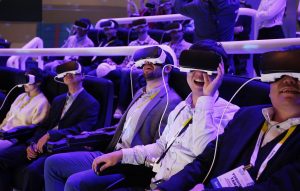
Introduction
In recent years, virtual events have emerged as a transformative force in the entertainment industry. The convergence of technology and creativity has given rise to a new paradigm where geographical boundaries are no longer a constraint, and the possibilities for engagement are virtually limitless. This article delves into the multifaceted impact of virtual events on the entertainment landscape, examining how they are reshaping the way we experience concerts, festivals, theater, and other forms of entertainment.
The Rise of Virtual Events

The concept of virtual events is not entirely new, but it has gained significant traction in the wake of the COVID-19 pandemic. With social distancing measures and lockdowns in place, traditional in-person events were either canceled or postponed, prompting a swift pivot to virtual platforms. This shift was not merely a stopgap measure; it marked the beginning of a new era in entertainment.
-
Technological Advancements
The rapid advancement of technology has been a key enabler of virtual events. High-speed internet, sophisticated streaming services, and interactive platforms have made it possible to deliver high-quality, immersive experiences to audiences worldwide. Virtual reality (VR) and augmented reality (AR) technologies are also playing a crucial role, offering unprecedented levels of interactivity and immersion.
-
Accessibility and Inclusivity
One of the most significant advantages of virtual events is their accessibility. Traditional events often come with geographical and financial barriers that limit participation. Virtual events, on the other hand, can be accessed from anywhere in the world, often at a fraction of the cost. This democratization of entertainment is making it possible for more people to engage with content that was previously out of reach.
Transforming Concerts and Music Festivals

Concerts and music festivals have traditionally been large-scale, in-person events that draw massive crowds. The transition to virtual platforms has introduced new dynamics, both for performers and audiences.
-
Live Streaming and On-Demand Content
Many artists and organizers have turned to live streaming as a way to connect with fans. Platforms like YouTube, Twitch, and Facebook Live have become popular venues for virtual concerts. Additionally, some events offer on-demand content, allowing fans to watch performances at their convenience.
-
Interactive Features
Virtual concerts are not just about watching a performance; they offer interactive features that enhance the experience. Live chats, virtual meet-and-greets, and interactive polls are just a few examples. Some platforms even allow fans to influence setlists or interact with performers in real-time, creating a more engaging and personalized experience.
-
Monetization Strategies
Monetizing virtual concerts is another area that has seen innovation. From pay-per-view tickets to virtual merchandise and exclusive behind-the-scenes content, artists and organizers are exploring various revenue streams. Virtual tip jars and crowdfunding campaigns are also becoming popular ways for fans to support their favorite artists directly.
Revolutionizing Theater and Performing Arts

Theater and performing arts have also embraced virtual platforms, offering new ways to experience live performances.
-
Virtual Theater Productions
Many theater companies have adapted their productions for virtual audiences. These virtual theater productions often incorporate multiple camera angles, special effects, and interactive elements to create a unique viewing experience. Some productions even use VR to offer a fully immersive experience.
-
Expanding Audiences
Virtual theater has the potential to reach a much broader audience than traditional in-person performances. People who might not have access to a particular theater due to geographical or financial constraints can now enjoy high-quality productions from the comfort of their homes.
-
Educational Opportunities
Virtual platforms are also being used for educational purposes. Workshops, masterclasses, and behind-the-scenes tours are becoming more accessible, providing valuable learning opportunities for aspiring artists and enthusiasts.
The Future of Virtual Events in Entertainment

As technology continues to evolve, the potential for virtual events in the entertainment industry is vast. Here are some trends and possibilities for the future:
-
Hybrid Events
Hybrid events, which combine in-person and virtual elements, are likely to become more common. These events offer the best of both worlds, allowing for physical attendance while also reaching a global virtual audience.
-
Enhanced Interactivity
Advancements in VR and AR will continue to enhance the interactivity of virtual events. Imagine attending a virtual concert where you can explore a 3D environment, interact with other attendees, and even control your viewpoint during the performance.
-
Personalization
Data analytics and artificial intelligence will enable more personalized experiences. Virtual platforms will be able to tailor content and recommendations based on individual preferences, creating a more engaging and relevant experience for each user.
-
Sustainability
Virtual events are also more environmentally sustainable compared to traditional in-person events. They reduce the need for travel, minimize waste, and lower the carbon footprint associated with large gatherings.
Conclusion
Virtual events are undeniably changing the entertainment landscape. They offer unprecedented accessibility, interactivity, and personalization, making it possible for more people to engage with a diverse range of content. As technology continues to advance, the possibilities for virtual events will only expand, offering new and exciting ways to experience entertainment. Whether through virtual concerts, theater productions, or other forms of entertainment, the future is undoubtedly digital, and the entertainment industry is poised to continue evolving in this dynamic landscape.










